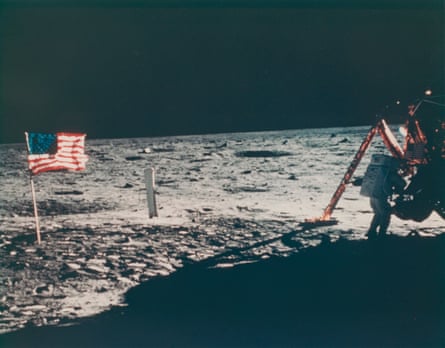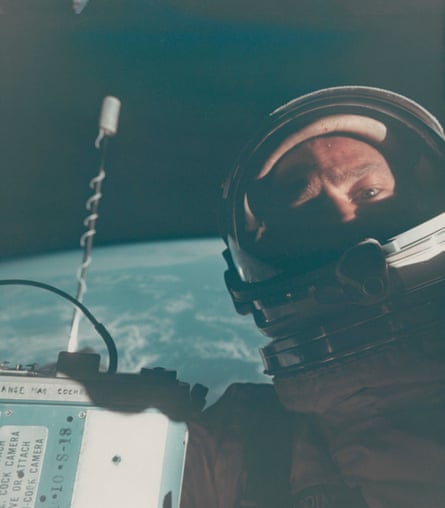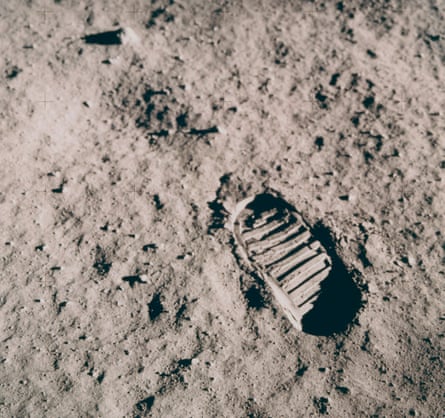Neil Armstrong’s giant leap for mankind is on sale to the highest bidder after a private collector released a treasure trove of Nasa images from spaceflight’s golden era for auction, including the only photograph taken of the first human walking on the moon.
The July 1969 snapshot is the highlight of the collection of 2,400 vintage images across 700 lots featured on the Christie’s of London website, including the first selfie from space by Armstrong’s Apollo 11 crewmate Buzz Aldrin and the epochal Earthrise photograph that captured the planet emerging above the moon’s horizon.
Bidding starts at £100 (about $132) for many of the photographs in the auction, which is being held online because of the coronavirus pandemic. Christie’s estimates that some of the better-known images will reach in excess of £50,000 ($66,000) individually.
![Panoramic view [Mosaic] of the Descartes landing site with the LM Orion, John Young, the Rover, the US flag and the Solar Wind Collector, April 16-27, 1972](https://i.guim.co.uk/img/media/dc2430e6822d07f78d7afdd5383ddb24296a8b9b/0_0_4000_1289/master/4000.jpg?width=445&dpr=1&s=none)
“The collection is the most comprehensive private collection of Nasa photographs ever presented at auction, and spans every visual milestone of the space program, from the early days of Mercury, the technical advances of Gemini and lunar orbiter, to the triumphs of Apollo,” Christie’s said in a press release promoting the sale.
“Through their cameras, the astronauts-turned-artists were able to convey to mankind the beauty and profundity of their experience in space, forever changing the way we see ourselves and our place in the universe.”
Voyage to Another World: the Victor Martin-Malburet Photograph Collection is a chronological journey of humankind’s achievements in space beginning with the early days of rocketry in the 1940s to the first color photograph of Earth and the moon together in the same still image, taken from the Voyager 1 space probe in 1977.

Amassed by Martin-Malburet, a 39-year-old Frenchman who has been hoarding space images from his teen years when he had dreams of becoming an astronaut, parts of the collection have been displayed in various guises over the years.
Most recently, images from the Apollo missions of the 1960s and early 1970s toured several prestigious art museums in Europe during the summer of 2019 to commemorate the 50th anniversary of the first human moon landing.
While the smaller number of landmark photographs are familiar to space enthusiasts, the vast majority of the collection is being seen publicly for the first time, having been hidden in archives for decades and viewed previously only by researchers at Nasa’s Johnson space center in Houston, Texas, or the Russian space agency Roscosmos.
Other notable images for sale include Laika, the first dog to orbit Earth, awaiting launch in a space capsule in the Soviet Union in 1957; the first shot of the back side of the moon taken in 1959; Blue Marble, the first full photograph of Earth from human eyes taken in 1972; and several from the Apollo 17 mission later that year in which Eugene Cernan and Harrison Schmitt were the last of the 12 humans ever to set foot on the moon.

Only four are still alive, among them former US senator Schmitt, 85, and Aldrin, 90, who tweeted in June 2018 that he was proud of taking the world’s first space selfie, during his 1966 flight aboard Gemini 12. “That was one expensive selfie stick!” he wrote.
Armstrong, who spoke the historic words: “One small step for [a] man, one giant leap for mankind” after stepping on to the lunar surface on 20 July 1969, died in 2012, aged 82, of complications following heart surgery. Nasa has plans to land the first woman and next man on the moon as early as 2024, although the estimated cost of up to $30bn of its Artemis program will come under close scrutiny during the upcoming administration of President-Elect Joe Biden.
Martin-Malburet, whose father was a prominent collector of 20th-century avant garde art in Paris, acquired his space collection from auctions, private collectors and dealers, and some directly from the astronauts themselves.

“The astronauts are often portrayed as great scientists and heroes but rarely are they hailed as some of the most significant photographers of all time,” he said. “They captured, with skill and daring, photographs which immediately embraced the iconography of the sublime, inspiring awe and wonder.”
The Christie’s sale is split into two parts, with bidding open until 19 and 20 November respectively.
